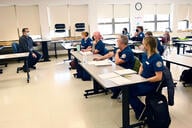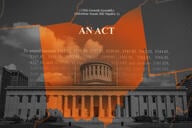You have /5 articles left.
Sign up for a free account or log in.
President Obama recently praised a City University of New York experiment to help more students graduate from community college. So did faculty unions, which have pushed back hard on other ideas that emanate from CUNY's central office.
Fans of Accelerated Study in Associate Programs (ASAP) like its comprehensive approach to dismantling the hurdles low-income students face. And the results are compelling.
Students in the program are almost twice as likely to earn a degree, according to a new study from MDRC, a nonprofit research group. The research found that 40 percent of those students earned an associate degree in three years, easily topping the 22 percent rate of their peers in a control group who completed, and far surpassing typical community college graduation rates.
“The figures are terrific,” said Barbara Bowen, president of the Professional Staff Congress, CUNY's faculty union. “If you invest more per student, you get a better result.”
So far 8,672 students have enrolled in ASAP, according to CUNY, at 7 of the system's colleges (see list below). But the new study suggests that the program could be expanded, perhaps even broadly, without getting too expensive.
That might be surprising, given the wide range of supports participating students receive, including free tuition, textbooks and public transportation, as well as regular (and mandatory) access to an adviser with a relatively small caseload.
That all adds up to annual cost of $4,700 per student, on top of the roughly $8,000 CUNY spends each year to educate a full-time student. To help pay for the program, which began in 2007, the city kicked in $35 million.
Yet ASAP is cost-effective, at least per degree produced, which is an increasingly popular way for lawmakers to look at return on investment in higher education.
“The cost per graduate is less because we're graduating twice as many students,” said Donna Linderman, CUNY's university dean for student success initiatives.
The total cost to CUNY for a degree earned by a student in the tuition-free program was $105,000, according to MDRC, compared to $118,000 in the control group. The study's sample included 451 ASAP students and 445 students in the control group.
The expense is dropping, too, as the program expands and up-front spending pays off. ASAP will cost an extra $3,900 per student this year, according to the system.
Participating CUNY Colleges
Borough of Manhattan Community College
Bronx Community College
Hostos Community College
Kingsborough Community College
LaGuardia Community College
Medgar Evers College
Queensborough Community College
CUNY officials have big goals for the accelerated degree track. By 2017 they want to enroll 13,000 students in the program, which is set to expand next fall to the system's College of Staten Island and the New York City College of Technology.
The model also is being exported to Ohio. Three community colleges in the state -- Cincinnati State Technical and Community College, Lorain County Community College, and Cuyahoga Community College -- plan to try it.
Some tweaking of the NYC version will be required. For example, the three colleges likely will issue a gas card to participating students rather than a MetroCard (which cost $112 per month in 2013).
College officials in other states have called about the program, too.
“We're hoping to extend that work with CUNY to other colleges around the country,” said Michael J. Weiss, a senior associate with MDRC who coauthored the study.
No Silver Bullet
ASAP's breadth appears to be a big part of its success.
“This is a package program,” said Weiss. “Any individual component would never have this kind of effect.”
Students who apply and are admitted must attend college full-time in exchange for the free tuition, books and subway fare. CUNY encourages students to take a 12-credit course load per semester as well as summer and winter sessions. They enroll in blocks of courses, or learning communities, in their first year, as well seminars on topics such as goal setting and study skills.
ASAP admits generally arrive with the same deficiencies in math and reading as their peers. The typically take remedial courses early in the program. And they are expected to graduate in three years.
“We give a lot,” said Linderman. “But we expect a lot from students.”
Advising is an important part of the program. The MDRC study said the student-to-adviser ratio in ASAP is less than 80 to 1. Since the study was completed, each adviser works with no more than 150 students. That might seem like a lot, but many 2-year colleges have more than 1,000 students per adviser. The ratio was more than 600 to 1 for the study's control group.
As a result, ASAP students meet with their advisers much more often. They are required to see an adviser at least twice a month. Those that did averaged 38 meetings per year. Their peers in the control group who met with an adviser only did so six times a year.
Advising accounts for roughly 13 percent of ASAP's costs, said Susan Scrivener, a senior associate with MDRC and one of the study's coauthors.
“Because advisers have lower caseloads, they get to know the students,” she said.
Students in the program also were more likely to meet with career services staff and tutors, and to see them more often.
Bowen said the low student-to-adviser ratio is crucial. “That tells the whole story,” she said. “If there's enough support for students, they will do beautifully.”
Students in the accelerated track earned an average of 48 credits after 3 years, according to the study, compared to the average of 39 credits for the control group. MDRC also found that fully one-quarter of ASAP students had transferred after three years and were enrolled in a four-year institution. Only 17 percent of their peers had made that jump.
Even well-designed programs that seek to increase graduation rates face an uphill battle. CUNY officials said they worked hard on some seemingly mundane administrative details that could have undermined ASAP if not executed properly. For example, clear messaging to students on the program's Web site was a must, they said.
Scrivener also praised CUNY for monitoring ASAP's progress over the years and making helpful corrections.
“This is a very well-run program,” she said.
Now that firm results are in, across several different institutions, CUNY is confident it has cracked the formula for getting students to the finish line.
“It doesn't matter that you have a particularly talented director or a president who pays attention. The model works,” said John Mogulescu, the senior university dean for academic affairs and the dean of the CUNY School of Professional Studies. “For us it's a breakthrough program."




